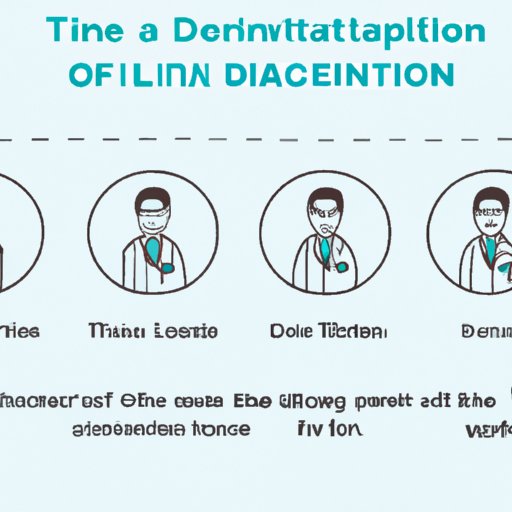Introduction
Becoming a doctor requires a significant amount of time and dedication. From pre-medical education to medical school, residency, fellowship, and licensing exams, there are several steps involved in the process. So, how long does it take to become a doctor?
This article provides an overview of the length of time needed to become a doctor. We’ll explore the different steps involved in the process and examine the typical timeline for becoming a doctor. Additionally, we’ll discuss factors that can affect the timeline and alternate ways to become a doctor.
The Road to Becoming a Doctor: How Long Does It Take?
To become a doctor, you must go through a series of steps. As noted by the National Institutes of Health (NIH), these steps include pre-medical education, medical school, residency, fellowship, and licensing exams. Each step takes a different amount of time, so the total length of time needed to become a doctor varies depending on the individual.

Breaking Down the Steps to Becoming a Doctor and How Long Each Takes
Let’s take a closer look at each step in the process and how long it typically takes to complete it.
Pre-Medical Education
Before applying to medical school, you must earn a bachelor’s degree from an accredited college or university. According to the Association of American Medical Colleges (AAMC), obtaining a bachelor’s degree typically takes four years. However, some students may need additional time if they decide to pursue a double major or take a gap year.
Medical School
Once you have your bachelor’s degree, you can apply to medical school. Medical school typically takes four years to complete. During this time, you will take courses related to anatomy, physiology, pathology, pharmacology, and other topics. You will also be required to complete clinical rotations at hospitals and other healthcare facilities.
Residency
After graduating medical school, you will need to complete a residency program. A residency program usually lasts three to seven years and provides hands-on training in a specialty. During this time, you will gain experience in diagnosing and treating patients under the supervision of experienced physicians.
Fellowship
For those who wish to specialize in a certain field, a fellowship is recommended. Fellowships typically last one to three years and provide advanced training in a specific area of medicine. Some specialties, such as cardiology or neurosurgery, require fellowships.
Licensing Exams
Once you have completed your residency or fellowship, you will need to take and pass licensing exams. The United States Medical Licensing Examination (USMLE) is a three-step exam required for medical licensure in the U.S. Passing each step of the exam typically takes six to eight weeks.
Understanding the Timeline for Becoming a Doctor
As noted by the NIH, the average timeline for becoming a doctor is approximately 11 to 15 years. However, this timeline can vary depending on the individual and the type of medical specialty they pursue. For example, if you choose to pursue a specialty such as neurology or emergency medicine, it could take longer than 15 years to become a doctor.
Additionally, there are a few factors that can affect the timeline for becoming a doctor. For example, taking a gap year or pursuing a dual degree could add more time to the process. Also, some medical schools may require applicants to complete post-baccalaureate programs before enrolling in medical school.
It’s important to understand the timeline for becoming a doctor and the different steps involved in the process. Be sure to research the requirements for medical licensure in your state and plan accordingly.

An Overview of How Long It Takes to Become a Doctor
So, how long does it take to become a doctor? The average timeline for becoming a doctor is 11 to 15 years, depending on the individual and the type of medical specialty they pursue. Pre-medical education typically takes four years, medical school four years, residency three to seven years, fellowship one to three years, and licensing exams six to eight weeks.
It’s important to note that there are alternate ways to become a doctor. For example, some states allow individuals with a bachelor’s degree to become a doctor without attending medical school. These programs typically involve completing an accelerated curriculum and passing licensing exams.
Conclusion
Becoming a doctor is a lengthy and rigorous process. On average, it takes 11 to 15 years to become a doctor, depending on the individual and the type of medical specialty they pursue. Pre-medical education, medical school, residency, fellowship, and licensing exams are all necessary steps in the process.
It’s important to understand the timeline for becoming a doctor and the different steps involved. Be sure to research the requirements for medical licensure in your state and plan accordingly.
(Note: Is this article not meeting your expectations? Do you have knowledge or insights to share? Unlock new opportunities and expand your reach by joining our authors team. Click Registration to join us and share your expertise with our readers.)
